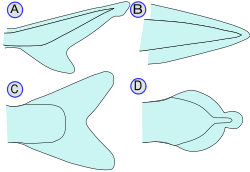 Chordates
Chordates
Fins
The fins are the most distinctive features of a fish, composed of bony spines protruding from the body with skin covering them and joining them together, either in a webbed fashion, as seen in most bony fish, or more similar to a flipper, as seen in sharks. These usually serve as a means for the fish to swim. Fins can also be used for gliding or crawling, as seen in the flying fish and frogfish. Fins located in different places on the fish serve different purposes, such as moving forward, turning, and keeping an upright position.
Spines and rays
In bony fish, most fins may have spines or rays. A fin can contain only spiny rays, only soft rays, or a combination of both. If both are present, the spiny rays are always anterior. Spines are generally stiff and sharp. Rays are generally soft, flexible, segmented, and may be branched. This segmentation of rays is the main difference that separates them from spines; spines may be flexible in certain species, but they will never be segmented.
Spines have a variety of uses. In catfish, they are used as a form of defense; many catfish have the ability to lock their spines outwards. Triggerfish also use spines to lock themselves in crevices to prevent them being pulled out.
Types of fin- Dorsal fins are located on the back. A fish can have up to three of them. The dorsal fins serve to protect the fish against rolling, and assists in sudden turns and stops.
- In anglerfish, the anterior of the dorsal fin is modified into an illicium and esca, a biological equivalent to a fishing pole and a lure.
- The bones that support the dorsal fin are called Pterygiophore. There are two to three of them: "proximal", "middle", and "distal". In spinous fins the distal is often fused to the middle, or not present at all.
Caudal Fins
- The caudal fin is the tail fin, located at the end of the caudal peduncle.
- The tail can be heterocercal, which means that the vertebrae extend into a larger lobe of the tail or that the tail is asymmetrical
- Epicercal means that the upper lobe is longer (as in sharks)
- Hypocercal means that the lower lobe is longer (as in flying fish)
- Protocercal means that the caudal fin extends around the vertebral column, present in embryonic fish and hagfish. This is not to be confused with a caudal fin that has fused with the dorsal and anal fins to form a contiguous fin.
- Diphycercal refers to the special, three-lobed caudal fin of the coelacanth and lungfish where the vertebrae extend all the way to the end of the tail.
- Most fish have a homocercal tail, where the vertebrae do not extend into a lobe and the fin is more or less symmetrical. This can be expressed in a variety of shapes.
- The tail fin may be rounded at the end.
- The tail fin may be truncated, or end in a more-or-less vertical edge (such as in salmon).
- The fin may be forked, or end in two prongs.
- The tail fin may be emarginate, or with a slight inward curve.
- The tail fin may be lunate, or shaped like a crescent moon.
- The anal fin is located on the ventral surface behind the anus. This fin is used to stabilize the fish while swimming.
- The paired pectoral fins are located on each side, usually just behind the operculum, and are homologous to the forelimbs of tetrapods.
- A peculiar function of pectoral fins, highly developed in some fish, is the creation of the dynamic lifting force that assists some fish, such as sharks, in maintaining depth and also enables the "flight" for flying fish.
Bigeye tuna Thunnus obesus showing finlets and keels.
Drawing by Dr Tony Ayling- In many fish, the pectoral fins aid in walking, especially in the lobe-like fins of some anglerfish and in the mudskipper.
- Certain rays of the pectoral fins may be adapted into finger-like projections, such as in sea robins and flying gurnards.
- The "horns" of manta rays and their relatives are called cephalic fins; this is actually a modification of the anterior portion of the pectoral fin.
- The paired pelvic or ventral fins are located ventrally below the pectoral fins. They are homologous to the hindlimbs of tetrapods. The pelvic fin assists the fish in going up or down through the water, turning sharply, and stopping quickly.
- In gobies, the pelvic fins are often fused into a single sucker disk. This can be used to attach to objects.
- The adipose fin is a soft, fleshy fin found on the back behind the dorsal fin and just forward of the caudal fin. It is absent in many fish families, but is found in Salmonidae, characins and catfishes.
- Some types of fast-swimming fish have a horizontal caudal keel just forward of the tail fin. This is a lateral ridge on the caudal peduncle, usually composed of scutes (see below), that provides stability and support to the caudal fin. There may be a single paired keel, one on each side, or two pairs above and below.
- Finlets are small fins, generally behind the dorsal and anal fins (in bichirs, there are only finlets on the dorsal surface and no dorsal fin). In some fish such as tuna or sauries, they are rayless, non-retractable, and found between the last dorsal and/or anal fin and the caudal fin.
For every fin, there are a number of fish species in which this particular fin has been lost during evolution.
 types of caudal fin :
types of caudal fin :
(A) - Heterocercal, (B) - Protocercal,
(C) - Homocercal, (D) - Diphycercal

|